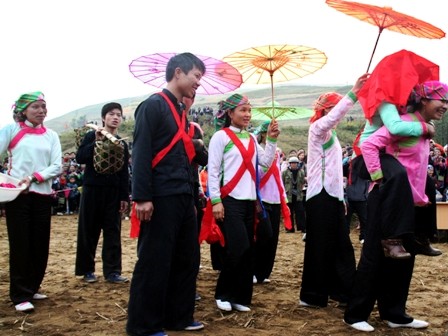(VOVworld) – The Giay people care a great deal about marriage and the continuation of the family line. Their least concern is a family’s wealth or poverty. For them, the most important things are morality, family tradition, and respect.
In the past the Giay upheld the custom of arranged marriage. Parents often asked their relatives or friends to find a good partner for their child in or near their village. Now young people get to know each other when they visit relatives or friends and join call-and-response singing events. When a young man and woman fall in love, they ask their parents to prepare a wedding. San Chang lives in Ta Van Giay hamlet, Sa Pa township, Lao Cai province: “
If the two families already know each other, it’s unnecessary for them to visit each other’s house. If not, the man will want to meet the woman’s family and her family will want to see the man’s house. The woman wants to know about the family she is going to live with – their education, traditions, and living conditions. If her family accepts, they will give the woman’s horoscope to the man’s family to take to a sorcerer to compare with the man’s horoscope. If the two horoscopes match, the man’s family will bring a present to the woman’s family to make a betrothal proposal.”
The groom will bring to the bride’s family a pair of roosters, a pair of ducks, and a pig as betrothal gifts. The bride’s family will ask for additional marriage presents. Customarily these will include pork and alcohol for the wedding party, a silver bracelet and necklace and new clothes for the bride to bring with her to her husband’s house, and rice to repay the bride’s parents for bringing her up. The Giay believe that the bigger the wedding party, the happier the couples will be. The best time for a wedding is the lull between the 11th and the 2nd lunar month when all the villagers can attend.

Wedding of the Giay in Lao Cai (photo: langvietonline.vn) |
The welcoming-the-bride-home delegation must consist of 2 old couples, who are well-spoken and have happy families, a groomsman, two bridesmaids, a younger brother, who will lead a horse carrying his sister-in-law, and several people carrying presents. Chang again: “The bride’s family will block the gate with a table on which they have placed 8 cups of alcohol. When the groom’s family arrives, they will sing call and response and the groom’s people will drink the alcohol. After that they will be let in. In the past they also put thorny trees or an ant’s nest to block the gate. Now the procedures have been simplified. The groom will give lucky money to the bride’s family before going into the house.”
Entering the house, the groom and the groomsman bow in front of the altar. The groom’s delegation will be offered a lot of alcohol and they are not supposed to refuse. Chang continues: “When they take the bride out of the house, the bride’s sisters and aunts will try to pull her back to show their feelings. The groom’s family will give them lucky money.”
The bride will carry a mirror in front of her chest, symbolizing her purity; some onion, garlic, and seedlings, symbolizing fertility; and a rooster, which is considered a sacred animal, to chase away evils and guide her way. Vang Thi Non of Sapa talks about wedding costumes. “The bride will carry a suitcase containing her clothes, blankets, and accessories. She wears a blue shirt, silk pant, a red headscarf, and a pair of walking shoes. When she arrives at the groom’s house, she will change into black clothes. The bride’s relatives will take her shoes home.”
Choosing the time for each ritual is very important, especially the time to enter the husband’s house to begin a new life. Hoang Van Ngan in Bat Xat district says: “We often welcome the bride in the early morning, when it is still dark. The groom’s family places a three-step stair in front of the door and the couple has to climb on it to enter the house.”
The couple will bow in front of the altar and ask for permission for the bride to be a family member. Then the mother-in-law will show her daughter-in-law around the house.